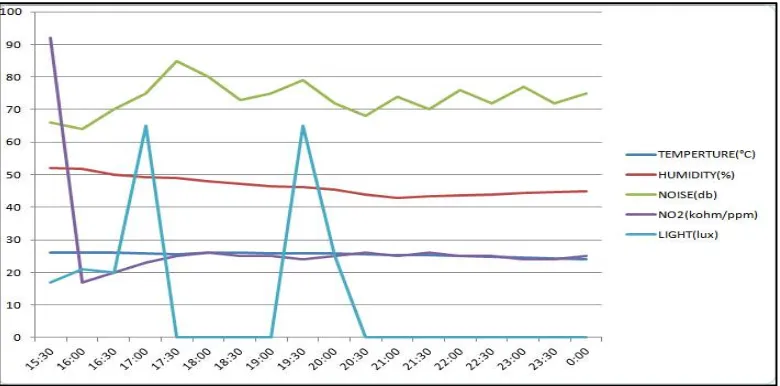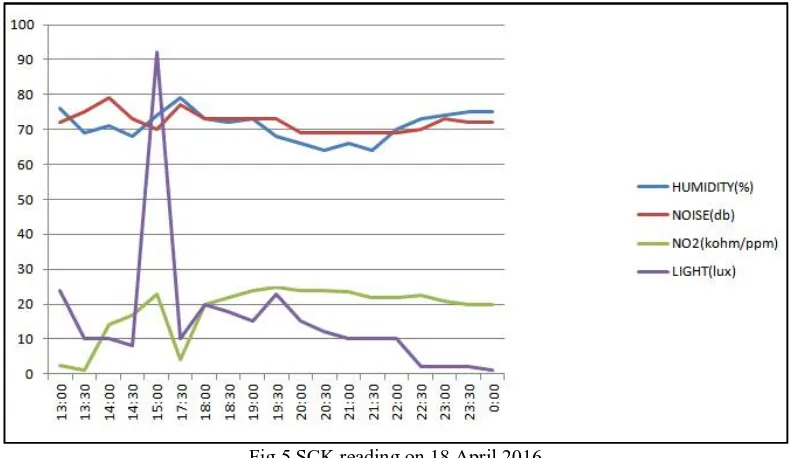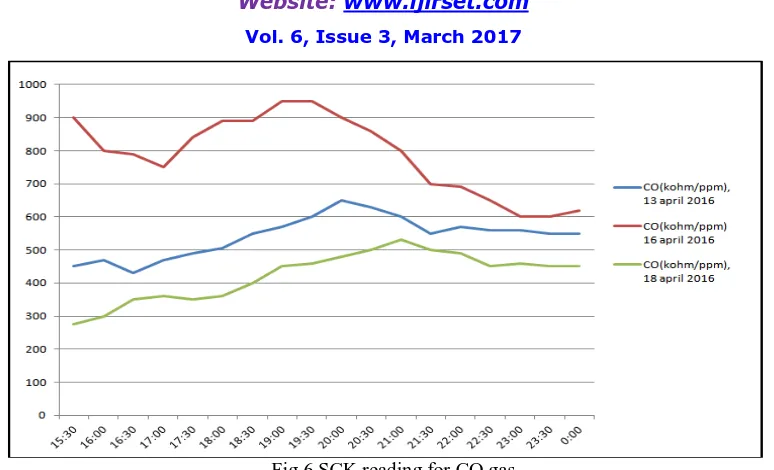Environmental Monitoring
Using SCK
Kotipalli Manasa1, Dowlapalli Aruna2
Assistant Professor, Department of ECE, Nalanda Institute of Engineering and Technology, Guntur,
Andhra Pradesh, India1
PG Student, Department of EIE, GITAM University, Visakhapatnam, Andhra Pradesh, India2
ABSTRACT: Environmental studies bring together the principles of sciences, economics and social sciences to solve contemporary environmental problems. It is a broad field of study that includes the natural environment and the built environment, and the relationship between them. Environmental scientists work on subjects like the understanding of earth processes, evaluating alternative energy systems, pollution control, alleviation of natural resources and the effects of global climate change. A key element of an effective environmental scientist includes the ability to relate space, and time relationships as well as quantitative analysis. Present researches and environmental scientists mainly focus on continuous monitoring of environmental data and its analysis. Continuous monitoring has been done using Smart Citizen Kit (SCK) using multiple sensors with Arduino.
KEYWORDS: Environmental Sciences, Global climate change, Natural resources, Smart Citizen Kit
I. INTRODUCTION
Smart Citizen is an open environment monitoring platform to generate participation of people in the cities to collect and monitor their ambient environment data and analyse it. The objective of the platform is to serve as a node to build productive and open indicators, and distributed tools, and encourage the collective construction of the city for its own inhabitants. An Open-Source environmental Monitoring Platform has an Arduino compatible Hardware, data visualization web API, and mobile/computer app. This Smart Citizen kit works on geo location, Internet and hardware and software for data collection and sharing and analysing it (Smart Citizen Kit - SCK, REST full API, App and, the web community), and (in a second phase) the production of objects it connects also the people with their surrounding environment in their city to create more effective relationship between resources available, technology utilized and communities present in the urban environment. The goal of the environmental monitoring is to allow anyone to collect the data, visualize it, and share it with others with very little hassle.
II. LITERATURE SURVEY
ISSN(Online) : 2319-8753 ISSN (Print) : 2347-6710
I
nternational
J
ournal of
I
nnovative
R
esearch in
S
cience,
E
ngineering and
T
echnology
(An ISO 3297: 2007 Certified Organization)
Website: www.ijirset.com
Vol. 6, Issue 3, March 2017
Fig 1 Smart Citizen Platform
The lowest layer of IOT is made up of smart devices which are integrated with sensors. The sensors enable the inter connection of the physical and digital worlds allowing real-time information to be collected and processed. Most sensors require connectivity to the sensor gateways. This can be in the form of a Local Area Network (LAN) such as Ethernet and WiFi connections or Personal Area Network (PAN) such as ZigBee, Bluetooth and Ultra- Wideband (UWB).
As the adoption of IOT becomes pervasive, data that is captured and stored becomes huge. One of the main concerns that the IOT has to address is privacy.
III. THEORITICAL APPROACH
A complete study has been done on Smart Citizen Kit (SCK) and analysis of the environmental data with SCK. A proto type SCK has been designed and identifying the further developments. Monitoring system is designed for proto type SCK for the data to be conveyed to the server (or) operating from some other location. The environmental data collected from SCK sensors are taken and plotted using MS Excel.
The Smart Citizen Kit is a piece of hardware comprised of a sensor and a data-processing board, a battery and an enclosure. The first board carries sensors that measure air composition (CO and NO2), ambient temperature, and humidity of air, light intensity and sound or noise levels. Once it’s set up, the device will stream data measured by the sensors over WiFi using the wireless module available on the data-processing board. The device’s low power consumption allows for placing it on balconies and windowsills.
Power to the device can be provided by a solar panel or battery. The Kit is Arduino compatible and all the design files are open source files.
The main aim is to monitoring of environmental data using SCK and design of prototype SCK.
1. Monitoring of environmental data and analysis using SCK
2. Designing a system for detecting the environmental data using Arduino UNO R3
3. Hardware board, Sensors and GPRS.
4. Designing a monitoring section for retrieving the environmental data and posting the data.
The preparation of prototype of the smart citizen kit using Arduino UNO R3 Hardware board with DIP ATmega328, Sensors and GPRS can be done.
In which the hardware consists of the following modules:
1. Arduino UNO R3 Hardware board
2. Sensors (Light, Noise, Temperature, Humidity & Gas sensor)
3. WiFi Module
4. Power Supply
Fig 2 Smart Citizen Monitoring
1. Arduino UNO R3 Hardware board
Both versions of the SCK (1.0 and 1.1) are using the same CPU, ATMEGA32U4.Only difference that the 1.0 works at
5V and 16MHZ while 1.1 works at 3.3V and 8MHZ.We’ve improved the power consumption in version 1.1. The
sensor board contains the sensors for measuring all the parameters like NO2 and CO gases, sunlight, noise pollution, temperature, humidity. Also, the sensor board has an I2C bus, which allows expanding the SCK to other kind of sensors
also.
2. Sensors
To measure the CO and NO2 we chose E2V sensors which are based on oxide semiconductors. Their electrical
conductivity is due to the reaction between the semiconductor and the gases in the atmosphere.
The light sensor is a basic element to know the light pollution. In version 1.0, was used a LDR (light-dependent resistor) whose voltage varies on the light conditions present, while for 1.1 version a photodiode BH1730FVC is used.
This sensor contains an I2C bus that gives us directly the amount of light in ambient and infrared light.
The noise sensor is based on an electret microphone. For the version 1.0 WM-61A was used as the microphone, the captured audio signal is passed through an operational amplifier configured as band pass filter.
To measure temperature and humidity a module that integrates both sensors was used. For version 1.0 the RHT22 was used, it has one wiredigital interface. But for version 1.1 the SHT21 was used, it has I2C protocol and faster response
between measures than the RHT22.
3. WiFi Module
The SCK, like most Arduino chips, has the ability to communicate through serial protocol (when plugged with a proper USB cable). The SCK uses the WiFly module to communicate with your WiFi router. Anyway, through serial communication you will be able to send the commands directly with this module to set your WiFi settings and extract
the MAC address used by our server to verify your identity. The RN-131 module is a standalone, embedded wireless
ISSN(Online) : 2319-8753 ISSN (Print) : 2347-6710
I
nternational
J
ournal of
I
nnovative
R
esearch in
S
cience,
E
ngineering and
T
echnology
(An ISO 3297: 2007 Certified Organization)
Website: www.ijirset.com
Vol. 6, Issue 3, March 2017
1. Ultra-low power: 4 uA sleep, 40 mA Rx, 210 mA Tx
2. High throughput, 1 Mbps sustained data rate with TCP/IP and WPA2
3. 8 analog sensor interfaces
4. Accepts 3.3-V regulated or 2 to 3 V battery
5. Wi-Fi Alliance certified for WPA2-PSK
4. Power Supply
For charging the battery there are two ways, USB or solar panel. To carry out the charging we are using MCP73831 IC. For charging the battery in 1.0 version the solar panels have to be 12v and 500mA. In 1.1 version, the solar panel can be more versatile in terms of amperage. For solar panel charging, depending on the sunlight conditions the solar panel produces up to 12v, we have to reduce the voltage to 5v to feed up the Vin of the MCP73831 charger IC. To carry out
this task we are using the LM2674 IC, a very efficient IC, with a rate of 91% of performance.
IV. IMPLEMENTATION AND ANALYSIS
In the website smartcitizen.com, a step by step process to join the Smart Citizen family is available to add the smart citizen kit (SCK) the platform. Currently only Google Chrome in Win, Mac and Linux is supported for the SCK configuration process. In order to have your kit connected to the Smart Citizen platform, we need a few steps involving the connection of your kit to your computer. The guidelines will help to register the kit to the platform, setup your kit’s Wi-Fi settings and update its firmware. Once you’ve added your SCK to the platform and then by capturing and sending data correctly, you can interact with the platform in several ways. Through the website we can visualize the data, download the data and interact with the data through the API.
Fig 3 SCK reading on 13 April 2016
The above figure 3 shows the reading on 13 April 2016 in Vishakapatnam. As we can see the plotting is for environmental parameters like Temperature,Humidity,NOIse,NO2 and light. There is more fluctuation for noise and
Fig 4 SCK reading on 16 April 2016
The above graph 4 shows the reading for the same environmental parameters as mentioned above. All the reading of the parameters show slight fluctuation but the light parameter shows more fluctuation. These reading were also taken in Visakhapatnam.
Fig 5 SCK reading on 18 April 2016
ISSN(Online) : 2319-8753 ISSN (Print) : 2347-6710
I
nternational
J
ournal of
I
nnovative
R
esearch in
S
cience,
E
ngineering and
T
echnology
(An ISO 3297: 2007 Certified Organization)
Website: www.ijirset.com
Vol. 6, Issue 3, March 2017
Fig 6 SCK reading for CO gas
The above graph 6 shows the readings for CO gas on various days like 13 April,16 April,18 April 2016 in.
It can be seen that the gas levels are different on different on all days. This environmental parameter can be analyzed
V. CONCLUSION
Using SCK continuous monitoring can be done accurately. The SCK kit cost is very high as it is imported one. A proto type SCK which is of lost cost has also been introduced and designed to monitor the environmental data. Further developments are needed in the proto type SCK in view of accuracy and continuous monitoring as this prototype SCK will not monitor a continuous environmental data.
REFERENCES
[1] Smart sensing technology: Opportunities and challenges, B.F. Spencer, Jr., Manuel E. Ruiz-Sandova, and Narito kurata.
[2] Pines D. J. and Lovell Philip A. (1998). “Conceptual framework of a remote wireless health Monitoring system for large civil structures.” Smart materials and Structures. 7:5: 627-636.
[3] Krantz, D.; Belk, J,; Biermann, P. J.; Dubow, J.; Gause, L. W.; Harjani, R.; Mantell, S.; Polla,D. and Troyk, P.(1999) “Project update: applied research on remotely-queried embedded micro sensors” Proceedings of SPIE- The International Society for Optical Engineering. 3673. [4] Lemke, J. (2000). “A remote vibration monitoring system using wireless internet data transfer.”Proceedings –SPIE, International Society for
Optical Engineering. 3995:436-445. Lemke, J. (2000). “A remote vibration monitoring system using wireless internet data transfer.” Proceedings –SPIE, International Society for Optical Engineering. 3995:436-445.
[5] Dayashankar Dubey, Anjaneyulu T. (2002). “Smart Sensors”. [6] F.L. Lewis (2004). “Wireless sensor network”.
[7] The Internet of Things: How the Next Evolution of the Internet Is Changing
Everything. [Online] Available from: http://postscapes.com/cisco-internet-of-things-white- Paper-how-the-next-evolution-of-theinternet-is-changing-everything%20
[8] Stephane gervais-Ducouret(2011).Next smart sensors generation. [9] https://www.arduino.cc/en/Guide/Environment
[10] docs.smartcitizen.me.
[11] https://smartcitizen.me/about#hardware



